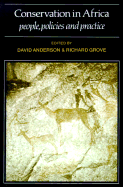Book contents
- Frontmatter
- Contents
- Preface
- List of contributors
- Introduction: The scramble for Eden: past, present and future in African conservation
- Part One Conservation ideologies in Africa
- Part Two Wildlife, Parks and Pastoralist
- Introduction
- 5 Pastoralism, conservation and the overgrazing controversy
- 6 Pastoralists and wildlife: image and reality in Kenya Maasailand
- 7 Integrating parks and pastoralists: some lessons from Amboseli
- 8 The Mursi and National Park development in the Lower Omo Valley
- Part Three Conservation priorities and rural communities
- Part Four Consequences for conservation and development
- Index
7 - Integrating parks and pastoralists: some lessons from Amboseli
Published online by Cambridge University Press: 04 April 2011
- Frontmatter
- Contents
- Preface
- List of contributors
- Introduction: The scramble for Eden: past, present and future in African conservation
- Part One Conservation ideologies in Africa
- Part Two Wildlife, Parks and Pastoralist
- Introduction
- 5 Pastoralism, conservation and the overgrazing controversy
- 6 Pastoralists and wildlife: image and reality in Kenya Maasailand
- 7 Integrating parks and pastoralists: some lessons from Amboseli
- 8 The Mursi and National Park development in the Lower Omo Valley
- Part Three Conservation priorities and rural communities
- Part Four Consequences for conservation and development
- Index
Summary
Introduction
Many of the regions with abundant and diverse wildlife communities remaining in East Africa are occupied by pastoralists. While livestock-herding people have coexisted with wildlife for thousands of years (Collett, Chapter 6), the potential for conflict over land use has increased in recent decades, following the intervention of modern governments in pastoralist lifestyles (Sandford, 1983). Some biologists and conservationists have concluded that pastoralists now compete severely with wildlife for food, water and living space (Huxley, 1961; Simon, 1962; Lamprey, 1983). They advocate the reduction of perceived conflicts by the exclusion of livestock and settlement from contested areas. Certain wildlife populations have been protected in this way in the short term, but this enforced exclusion can create hardships for local herdsmen (Turton, Chapter 8) and new conflicts with conservation interests (Myers, 1972). In recognition of the potential antagonism between the goals of nature preservation and the right of indigenous people to land tenure and use, some conservationists have proposed that the human neighbours of nature protection areas should receive direct, compensatory benefits from the reserves (Myers, 1972; IUCN, 1980; Cumming, 1981). The aim of this policy is to return to a sustainable coexistence between people and wildlife.
In the Amboseli area of southern Kenya, efforts to resolve conflicts between Maasai pastoralists and wildlife have been made by conservationists and government authorities since the 1950s.
- Type
- Chapter
- Information
- Conservation in AfricaPeoples, Policies and Practice, pp. 149 - 168Publisher: Cambridge University PressPrint publication year: 1988
- 2
- Cited by



